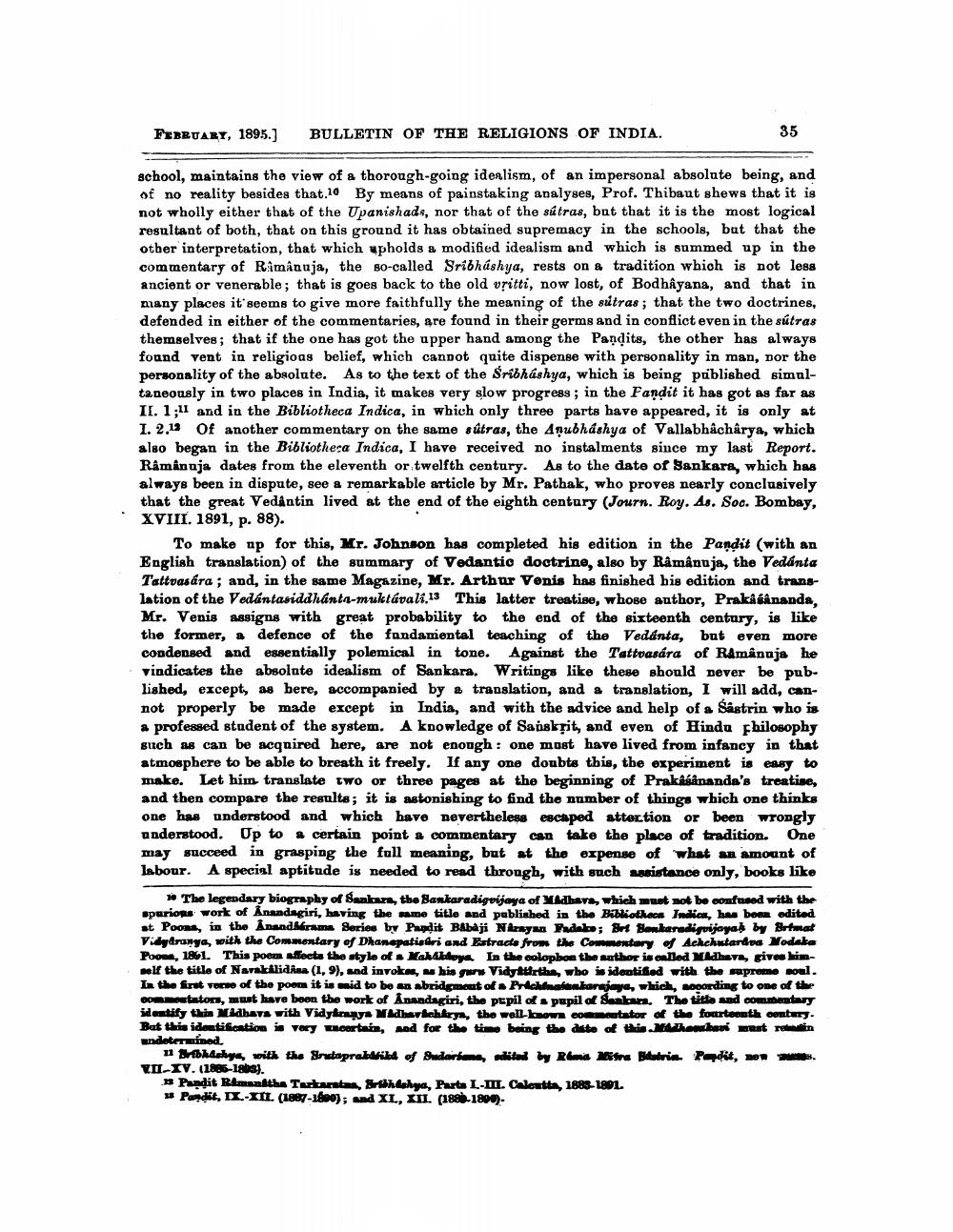________________
FEBRUARY, 1895.)
BULLETIN OF THE RELIGIONS OF INDIA.
35
school, maintains the view of a thorough-going idealism, of an impersonal absolute being, and of no reality besides that,10 By means of painstaking analyses, Prof. Thibaut shews that it is not wholly either that of the Upanishads, nor that of the sútras, but that it is the most logical resultant of both, that on this ground it has obtained supremacy in the schools, but that the other interpretation, that which upholds a modified idealism and which is summed up in the commentary of Ramanuja, the so-called Sribhúshya, rests on a tradition which is not less ancient or venerable; that is goes back to the old vritti, now lost, of Bodhảyana, and that in many places it seems to give more faithfully the meaning of the sutras; that the two doctrines, defended in either of the commentaries, are found in their germs and in conflict even in the sútras themselves; that if the one has got the upper hand among the Pandits, the other has always found vent in religioas belief, which cannot quite dispense with personality in man, por the personality of the absolute. As to the text of the Sribhashya, which is being published simaltaneously in two places in India, it makes very slow progress; in the Fandit it has got as far as II. 1;11 and in the Bibliotheca Indica, in which only three parts have appeared, it is only at I. 2.13 Of another commentary on the same sútras, the Anubhashya of Vallabhacharya, which also began in the Bibliotheca Indica, I have received no instalments since my last Report. Râminaja dates from the eleventh or twelfth century. As to the date of Sankara, which has always been in dispute, see a remarkable article by Mr. Pathak, who proves nearly conclusively that the great Vedantin lived at the end of the eighth century (Journ. Roy. As. Soc. Bombay, XVIII. 1891, p. 88).
To make ap for this, Mr. Johnson has completed his edition in the Pandit (with an English translation) of the summary of Vedantic doctrine, also by Ramândja, the Vedanta Tattvasára; and, in the same Magazine, Mr. Arthur Venis has finished his edition and translation of the Vedantasiddhanta-muktávali.13 This latter treatise, whose author, Prakasananda, Mr. Venis assigns with great probability to the end of the sixteenth century, is like the former, a defence of the fandamental teaching of the Vedanta, but even more condensed and essentially polemical in tone. Against the Tattvasára of Ramanuja he vindicates the absolute idealism of Sankara. Writings like these should never be pube lished, except, as bere, accompanied by a translation, and a translation, I will add, cannot properly be made except in India, and with the advice and help of a Sastrin who is a professed student of the system. A knowledge of Sanskrit, and even of Hindu philosophy such as can be acquired here, are not enough: one must have lived from infancy in that atmosphere to be able to breath it freely. If any one doubts this, the experiment is easy to make. Let him translate two or three pages at the beginning of Prakaśananda's treatise, and then compare the results; it is astonishing to find the number of things which one thinks one has understood and which have nevertheless escaped attention or been wrongly anderstood. Up to a certain point a commentary can take the place of tradition. One may succeed in grasping the full meaning, but at the expense of what an amount of labour. A special aptitude is needed to read through, with such assistance only, books like
*The legendary biography of Sankar, the Bankaradigvijaya of Madhavn, which must not be confused with the spurions work of Anandagiri, having the name title and pablished in the Bibliotheca Indian, has been edited at Poons, in the Anand Mrama Series by Pandit Babaji Narayan Padab; Bv Bankaradigvijaya4 by Brial Vidydranya, with the Commentary of Dhanepatidri and Estrade from the commentary of Achchutardpa Modala Poona, 1861. This poem sfects the style of Mahiye. In the colopbon the author is oled Madhen, gives himsol the title of Narakalidasa (1,9), and invokes, his gor Vidyarthe, who is identified with the mpreme soul. La the first voceo of the poem it is mid to be an abridgment of Prohmat.karabaya, which, woording to one of the commentaton, must have been the work of Anandagiri, the pupil of pupil of Sankara. The title and commentary identify thin Midhats with Vidyknya Madhavehkey, the well-baow contator of the fourteenth century. Bat this ideatification is very certain, and for the time being the dite of this the si mast rain undetermined.
n ibhdistys, with the Staprabofild of Sudarten, dited by Roma in detrin. Papdit, nem VIL-IV. (1886-18bs).
B Pandit Ramanatha Tarkarat, Bibh dahya, Parta L-IL. Calcutta, 1888-180L » Pudit, IX.-XIL. (1887-1800); and XL, XII. (188b-1800).




